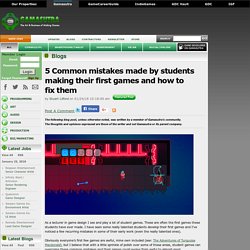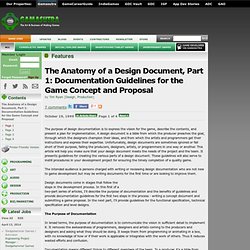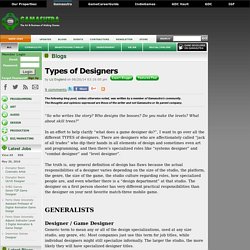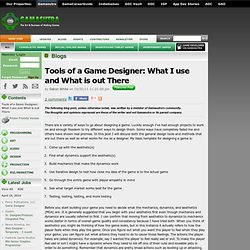

Why Does Celeste Feel So Good to Play? Level 3.2: Critical Analysis of Games: Game Design Concepts. Let’s Spec Into Talent Trees: A Primer for Game Designers. Game Design & Puzzlecraft by Lone Shark Games & Friends. Combat Game Designer: What Do Combat Designers Do? What Unique Skills Are Required for Combat Design? Did you know... Each year more than 25% of the student population of The Digital Animation & Visual Effects School (DAVE School) comes from outside the US to attend the school at Universal Studios in Orlando, Florida. There are currently students attending from Saudi Arabia, England, South Korea, Russia, Venezuela, and Dubai.
DAVE School can provide assistance in securing student visas and student housing. Learn more at www.DaveSchool.com. Do you have aspirations to become a game designer on a game like God of War, Mortal Combat, or Devil May Cry? The combat designer's main job or any designer’s job is to keep the design true to the pillars of the game.
Let’s take, for example, that you are tasked with creating a giant elephant mini-boss. DamageThe heavy attack should do more damage than the light attack, enough that any player could instantly tell a difference between attacks. Animation All attacks should have a tip off period to give the player time to react. What Games Are: Is Formal Game Design Valuable? Stuart Lilford's Blog - 5 Common mistakes made by students making their first games and how to fix them. The following blog post, unless otherwise noted, was written by a member of Gamasutra’s community.

The thoughts and opinions expressed are those of the writer and not Gamasutra or its parent company. As a lecturer in game design I see and play a lot of student games. These are often the first games these students have ever made. I have seen some really talented students develop their first games and I’ve noticed a few recurring mistakes in some of their early work (even the really talented ones). Obviously everyone’s first few games are awful, mine own included (see: The Adventures of Turquoise Macdonald), but I believe that with a little sprinkle of polish over some of these areas, student games can overcome these common mistakes and their games could evolve from awful to almost-good.
Every year I teach students how to make games and inevitable I am asked the question “how do I add a menu” or “how do I add pause functionality to the game”. Effectively Organize Your Game’s Development With a Game Design Document. Have you ever dived right in to developing a game, but found yourself having to constantly change aspects of the design or the gameplay due to a lack of planning?

You should consider using a game design document: a guiding vision of the game as a whole, pulling together ideas and plans for the design, development, and business sides of your game. Introduction To put it simply: we like to tell stories. Some true, some not so much. But the point is that we have been crafting tales for a very long time, and as time went by these tales began to evolve, becoming more complex, with richer details, with more and more fantastic backgrounds and appealing plots. And as the stories grew in complexity, so did the tools used in their making. Although video games were first just about getting the highest score possible when faced with a determined task, developers soon realized the endless possibilities laying ahead of them. How to Learn Board Game Design and Development. The Anatomy of a Design Document, Part 1: Documentation Guidelines for the Game Concept and Proposal. The Anatomy of a Design Document, Part 1: Documentation Guidelines for the Game Concept and Proposal The purpose of design documentation is to express the vision for the game, describe the contents, and present a plan for implementation.

A design document is a bible from which the producer preaches the goal, through which the designers champion their ideas, and from which the artists and programmers get their instructions and express their expertise. Unfortunately, design documents are sometimes ignored or fall short of their purpose, failing the producers, designers, artists, or programmers in one way or another. The Anatomy of a Design Document, Part 2: Documentation Guidelines for the Functional and Technical Specifications. The Anatomy of a Design Document, Part 2: Documentation Guidelines for the Functional and Technical Specifications Editor's note: Part 1 of this article was published on 10.19.99.

Did you ever look at one of those huge design documents that barely fit into a four-inch thick, three-ring binder? You assume that by its page count that it must be good. Well, having read some of those design volumes from cover to cover, I can tell you that size does not matter. They are often so full of ambiguous and vague fluff that it was difficult finding the pertinent information. This article is part two of a two part series that provides guidelines that when followed will ensure that your design documents will be pertinent and to the point. Functional vs Technical Specifications Traditionally in the game industry, there was only one spec.
This problem was tackled as more and more seasoned programmers and managers of business software development moved into games. Liz England's Blog - Types of Designers. The following blog post, unless otherwise noted, was written by a member of Gamasutra’s community.

Slaton White's Blog - Tools of a Game Designer: What I use and What is out There. The following blog post, unless otherwise noted, was written by a member of Gamasutra’s community.

The thoughts and opinions expressed are those of the writer and not Gamasutra or its parent company. There are a variety of ways to go about designing a game. Luckily enough I’ve had enough projects to work on and enough freedom to try different ways to design them. Some ways have completely failed me and others have shown real promise.